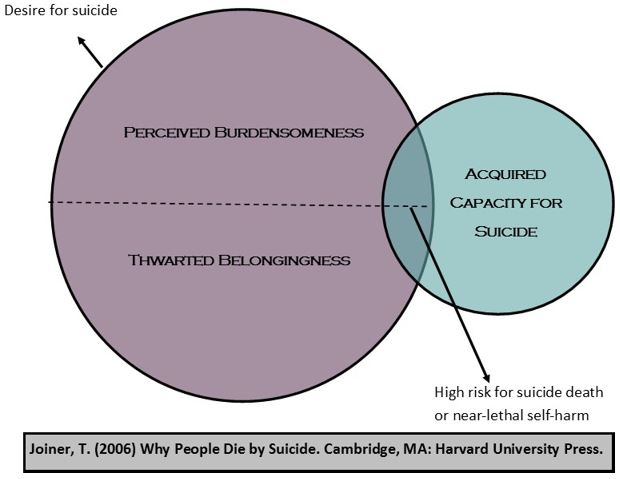Suicide is a mysterious enigma that challenges most people on many levels. One of the biggest aspects of the challenge is that we can never ask the person who died, “Why?” We can only infer from notes left behind, snippets of last conversations, and changes in behavior.
The question of “why” often haunts the minds of those bereaved by suicide. Frank Campbell once said that people who have lost a loved one to suicide often fall into a “Canyon of Why”—an abyss that becomes impossible to climb out of because the loved one is never there to answer the question. While we can never really know all the reasons why people die of suicide, there are some explanations that can help us fathom how individuals might find themselves in such a state of despair.
Most people who kill themselves believe that suicide is the only solution to their unbearable situation. Sometimes the analogy of what happened in New York City on September 11, 2001, gives people a framework for empathy. When one remembers September 11, some traumatic images etched in memories are the pictures of people jumping out of the World Trade Center. These people did not want to die. They were leaping to get away from the flames at their back.
In a similar manner, people who contemplate suicide are trying to escape some type of peril in their own lives or unbelievable pain in their souls. Most find it difficult to truly appreciate the flames that consume the minds of people who contemplate suicide.
Experts who study suicide coined the term “psychache” to describe the excruciating psychological pain that suicidal people experience, which often blocks the ability to see other potential solutions to problems. Psychache torments individuals who often do not want to die; they just cannot escape. Even though a pervasive sense of hopelessness stifles the ability for many to seek help, most suicidal people are very ambivalent about taking their lives. Another common metaphor people use to describe suicidal pain is feeling trapped in a completely darkened room with no way out.
A Model of Suicide Risk
In his book Why People Die by Suicide, Dr. Thomas Joiner explains that those who kill themselves not only have a desire to die, they have also learned to overcome the instinct for self-preservation. This theory goes beyond previous theories of suicide that were adequate in describing psychological risk factors but did little to explain why some people with those risk factors died by suicide and others did not.

Used with permission.
The theory states that wanting death is composed of two psychological experiences. The first is a perception of being a burden to others (perceived burdensomeness). According to Dr. Joiner, when people are in this state, they feel that their death is worth more to the people who love them than their life is. The word “perceived” is emphasized because frequently these thoughts are significantly distorted by depression or other mental disorders. While conventional wisdom might believe that the suicidal person is selfish, Dr. Joiner has found the opposite to be true.
Those who desire suicide often believe that they have become such a burden on others, everyone will be better off if they are not around. In other words, in the mind of the suicidal person, they are practicing ultimate selflessness. When we combine this emotionally painful experience of being a burden with isolation, suicidal despair often results.
Thus, the second common factor in the desire to die is a social disconnection to something larger than oneself (thwarted belongingness). As humans, we are hardwired to be in a relationship with others. For some people, this means just a couple of very intense relationships; for others, it means vast social networks.
When people lose key relationships with partners, children, colleagues, and friends through death, divorce, separation, moves, layoffs, or conflict, they can experience profound distress that can lead to a desire to die. Marked social withdrawal is not temperamental shyness. Rather, it’s a marked change: the person used to be engaged with friends and family, and now they withdraw into a bedroom or into their own head, and what you see is what Dr. Joiner calls “an inward gaze of bemused resignation and resolution.”
Acquired Capacity for Suicide
Suicidal thoughts become more lethal, however, when people have what Dr. Joiner has called an “Acquired Capacity for Suicide.” If suicide desire is the “I want to” part of the equation, “acquired capacity” is the “I can” part.
Dr. Joiner puts conventional wisdom on its head once again by challenging the notion that people who die of suicide are not cowardly—they are among our most brave. He argues, with a lot of research behind him, that those who are most likely to take lethal action on their suicidal thoughts are those who have a fearlessness of death. The following three main contributing factors for acquired capacity exist.
- You are born with it. Some people just come into the world with a temperament for risk-taking. They do not seem to be afraid of anything. Natural risk-takers in our society include law enforcement personnel and military, skydivers, adventure explorers, race car drivers, and emergency room doctors. These folks are not at risk for suicide unless they have the first half of the diagram, “desire for suicide.” Should that desire ever develop, however, they have less distance to cross to self-harm because the fear of death or pain is not as great as in other people.
- You learn it. Other people may not be born with this innate sense of courage, but they learn it over time by living through painful and provocative experiences. By being exposed to violence and life-and-death situations, people become more accustomed and less afraid. For some people, this means a history of physical or sexual abuse. For others, it is chronic injuries or illnesses that require adapting to high levels of pain. For still others, it may be repeated suicidal thoughts or attempts.
When Denver Bronco Kenny McKinley died by suicide, his death sent shock waves through the nation. However, when we look at the National Football League, we find a number of stories of suicide attempts and death, especially among retired players. At first glance, this is inconceivable. Our professional football players are national heroes. They have it all: fame, money, and undeniable talent. But they also have fearlessness and usually a history of powering through intense pain and debilitating injuries. The vast majority do not experience suicidal crises, but when they do, they have a shorter distance to go to reach a place of considering suicide since they are not afraid of pain. - You have access to and familiarity with lethal means. For example, you might have at hand firearms, lethal medications, and access to high places. The more comfortable a person is with the lethal means of suicide, the more likely he or she will choose that method should he or she find themselves wanting to die by suicide.
So, in Dr. Joiner’s theory, we must have both conditions to have increased risk for suicide. A desire for suicide is necessary but not sufficient. As mentioned earlier, suicidal thoughts are relatively common experiences, but suicide death is much less so. This is because most people who have suicidal thoughts, thankfully, do not have the acquired capacity for lethal self-harm.
Conclusion
As researchers ask questions to those most directly affected by the crisis of suicide—both the suicidal and those left behind—the mystery of suicide becomes less of an enigma and more of a significant preventable public health problem.
Further Reading:
Thomas Joiner, Why People Die by Suicide (Cambridge, Massachusetts: Harvard University Press, 2006).
William Styron, Darkness Visible: A Memoir of Madness (New York: Vintage, 1992).
Philip Rodgers, Understanding Risk and Protective Factors for Suicide: A Primer for Preventing Suicide, Suicide Prevention Resource Center, 2011.
Opinions expressed in Expert Commentary articles are those of the author and are not necessarily held by the author’s employer or IRMI. Expert Commentary articles and other IRMI Online content do not purport to provide legal, accounting, or other professional advice or opinion. If such advice is needed, consult with your attorney, accountant, or other qualified adviser.
Article originally published on International Risk Management Institute (IRMI): https://www.irmi.com/articles/expert-commentary/understanding-the-suicidal-mind


